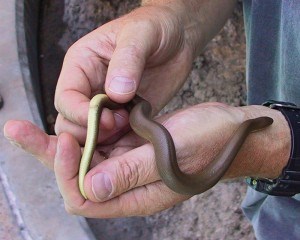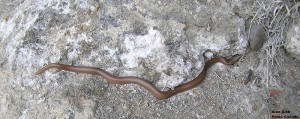
Jasper National Park is asking the public to be on the lookout for a very special snake this summer: the rubber boa.
To date, the wandering garter snake is the only snake species known to occur in the park. In recent years, however, Parks has received several descriptions of snakes which better describe rubber boa. This is surprising as the closest known population of rubber boa to Jasper is located adjacent to Kootenay National Park’s Radium Hot Springs.
The key to distinguishing a rubber boa from a wandering garter snake is body shape.
Whereas the wandering garter snake has a blunted head-end and a very tapered pointy tail-end the rubber boa is distinctly blunted at both ends. In fact, people often comment that on seeing a rubber boa they could not clearly distinguish the head from the tail. Rubber boa are brownish-grey in colour, with no distinguishing markings, somewhat like large earthworms.
The park would love to confirm the presence of these snakes. So, while hiking on park trails this spring and summer please keep an eye out. If you do spot what may be a rubber boa, snap a picture (very important) if you can, note the location, time and date and send the information via email to [email protected], or leave a phone message with your contact information at 780-852-6205. It would be hugely appreciated.

What do we know about this boa?
Rubber boa are secretive so not much is known about their populations. Mostly active at night, they spend about 25 per cent of their time above ground, undercover, and the remaining 75 per cent underground. While they have occasionally been found on vacant city lots, they usually live in grasslands and forests, or near streams and lakes.
Nothing like the giant man-eaters of horror movies, rubber boas are far from scary, unless you’re a baby shrew, mouse or vole, or an ophidiophobic! They’ve never been known to bite people—but if handled roughly, they will leave a smelly musk on you. Please remember, if you do find a rubber boa, it doesn’t want to be picked up any more than you would.
Rubber boas in the wild may live for over 30 years. One (wild-caught) boa kept in captivity lived to over 70! Like many long-lived animals, boas have a low reproductive rate. Females give birth to two to eight young in August or September.
Clutches may be as infrequent as every four years, and even a productive female will not bear young every year. Their low birth rate and long life span make rubber boas vulnerable to human activity. Because of this, they are classified in Canada as a species of Special Concern, and in B.C. as vulnerable (blue-listed).
As a cold-blooded animal, boas go into hibernation in the fall and re-emerge in April in order to survive cold winter temperatures. They will, however, put up with cool night-time temperatures through the summer, so they can hunt without becoming the hunted, avoiding predators such as birds of prey.
Despite their small size (30-80 cm long), these snakes are in the same family as boa constrictors and pythons and kill their prey in the same way. This ancient group of snakes has been found in 50-million-year-old fossils, and was apparently once widespread in North America. Now, however, only two species remain: the rubber boa and the rosy boa, found in California and Mexico. These are the only two boas found outside the tropics and subtropics.
Good luck on your search!
Parks Canada
Special to the Fitzhugh
